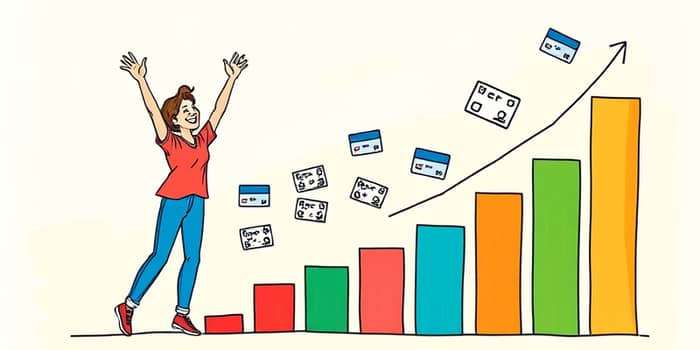
Credit card debt in the United States has reached unprecedented levels, surpassing $1.18 trillion in Q1 2025. Many consumers carry balances well beyond $7,000, and delinquency rates are climbing. In this landscape, tracking your debt payoff journey becomes not just helpful, but essential.
By monitoring every payment, interest charge, and balance reduction, you transform a daunting financial mountain into manageable steps. This article explores the current debt statistics, explains why tracking matters, offers practical methods, reviews payoff strategies, and highlights the emotional benefits of visible progress.
As of early 2025, more than 600 million credit card accounts are active in the U.S., roughly two per consumer. The average balance among those carrying unpaid debt is $7,321—up 5.8% from the previous year. Households often exceed $10,000 in combined balances.
Delinquency rates have ticked upward, with 4.3% of outstanding balances reported as delinquent. Late-stage delinquencies (over 90 days) are spiking, driven largely by credit cards and student loans. Over half of debtors (53%) have been carrying balances for more than a year.
Understanding these numbers reveals why a systematic approach is vital. Without clear visibility, balances can compound unchecked, leading to years of payments and thousands of dollars lost to interest.
People often make minimum payments and assume progress is occurring. Unfortunately, at a 20.42% APR, a $6,380 balance paid at $125 per month takes 121 months to clear—accruing $8,651 in interest.
Tracking your progress offers multiple advantages:
You don’t need complex systems to stay on track. Choose an approach that suits your style and resources.
Whichever method you choose, consistency is key. Schedule a weekly or monthly session to update your records and review your trajectory.
Tracking complements any payoff strategy by keeping you accountable and focused. Three popular methods include:
By tracking actual balances against these benchmarks, you can see when you’re ahead or behind expectations and adjust your payment amounts or strategy.
Formalizing a review process raises accountability. Consider scheduling a monthly or quarterly “personal finance meeting” where you:
Celebrate each milestone, whether it’s every $500 reduction, paying off a specific card, or cutting the timeline by several months. Recognizing progress regularly strengthens your commitment and makes long-term goals feel achievable.
Tracking debt payoff delivers more than numerical gains. As balances shrink, you’ll experience reduced stress and anxiety, knowing you’re actively reclaiming control over your finances. Lower balances also boost credit scores, improving access to favorable interest rates on mortgages and auto loans.
In households or partnerships, sharing progress fosters teamwork. A joint tracking sheet can promote mutual accountability and open communication, reducing conflict over financial decisions.
Ultimately, diligent tracking transforms debt repayment from a vague hope into a clear plan of action. By visually charting each payment, you build momentum, reinforce positive habits, and safeguard against future setbacks.
Start today: choose your tracking method, set realistic goals, and commit to regular reviews. With each milestone, you’ll gain confidence and clarity, steadily moving toward the freedom of a debt-free future.
References













